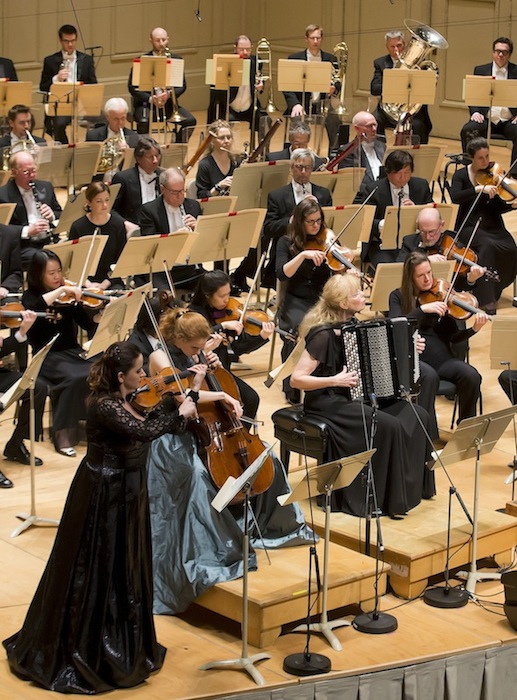Nelsons, BSO premiere Gubaidulina Triple Concerto, alongside shattering Shostakovich

Andris Nelsons congratulates Sofia Gubaidulina following the Boston Symphony Orchestra world premiere of her Triple Concerto Thursday night. Photo: WInslow Townson
Sofia Gubaidulina grew up in a time of political oppression. Her early music was deemed “irresponsible” by Soviet authorities for her use of alternative tunings. She found encouragement from Dmitri Shostakovich, who told her to continue along her own path.
That path, as it turned out, has come to transfix listeners in the West. Her violin concerto Offertorium has become a favorite with audiences around the world. The work is no stranger to Boston as the BSO, led by Charles Dutoit, has recorded it with violinist Gidon Kremer.
The Russian composer’s Triple Concerto, which was given its world premiere Thursday night at Symphony Hall by Andris Nelsons and the Boston Symphony Orchestra, is a departure from that familiar work, but it is no less enthralling.
The Triple Concerto is cast in a single unbroken movement spanning a half hour. Instead of the glistening textures of Offertorium, Gubaidulina’s new work is cast in darkness. Basses and brasses growl. Colors between the three solo instruments—violin, cello, and bayan—and the orchestra transform slowly. Harmonies shift like images in a kaleidoscope.

Violinist Baiba Skride, cellist Harriet Krijgh, and bayan player
Elsbeth Moser perform the world premiere of Sofia Gubaidulina’s Triple Concerto with Andris Nelsons and the Boston Symphony Orchestra Thursday night. Photo: Winslow Townson
The soloists, Baiba Skride (violin), Harriet Krijgh (cello), and Elsbeth Moser (bayan), played with firm commitment and concentration. Their parts are not showy; rather, their music offers commentary upon the shifting orchestral colors. A dense cluster chord in the bayan, a Russian accordion, is a constant theme in the piece.
In the central section of the work, the soloists engaged in moments of shimmering sonorities. Skride’s whistling harmonics were complemented by Krijgh’s silvery phrases. Moser played a downward glissando on the bayan by dragging a block across the keys. Cadenzas came across in free-flowing phrases, with Skride and Krijgh unleashing flourishes of double and triple stops.
The orchestral parts move glacially as well. Snarling basses transform subtly to a bright tapestry awash in fluttering violin and flute colors. Toward the end of the piece, a figure in the trombones winds its way into the French horns’ extreme upper range. Nelsons led a sensitive reading that drew playing of power and precision.
Gubaidulina’s Triple Concerto is one of her most important works. The audience seemed to recognize this, showering the composer and the musicians with cheers of appreciation.
The bulk of Thursday’s program was dedicated to Shostakovich’s Leningrad Symphony. Nelsons’ survey of the Soviet composer’s symphonies has been one of the most rewarding aspects of his tenure as music director, as shown by the Grammy Awards won for the BSO’s previous recordings of the Fifth, Eighth, Ninth, and Tenth Symphonies in this ongoing cycle.
The history of this 75-minute work includes a harrowing tale of its Leningrad premiere. Musicians managed to pull off the symphony despite starvation and death in the face of the Nazi’s 900-day siege of the Soviet city. Shostakovich’s work, with its dark wit and boisterous climaxes, is a refutation of militarism and, to some listeners, totalitarianism itself.
The symphony is not without its flaws. The famous invasion motive, heard in the expansive first movement, is a rather banal tune, which the composer repeats in a long crescendo in the manner of Ravel’s Bolero. In the middle movements, the symphony can seem overly repetitive with the musical lines failing to find direction.
Nelsons’ reading, though, steered clear of such interpretive potholes. The conductor has a firm feel for Shostakovich’s breadth and sense of irony, and his performance of the Leningrad brimmed with forward momentum and fine detail.
In the invasion theme, Nelsons infused each passing repetition with driving energy. The orchestra responded robustly to his guide. Climaxes were bold, flute and bassoon solos were both velvety and mournful, and the soft passages retained an edge-of-the-seat intensity.
The opening of the second movement moved at a nimble pace, and Nelsons mined a chamber–like dialogue from the wind solos and thin string textures. The third movement, possibly a depiction of the architecture of Leningrad, had moments of serenity. The conductor shaped the smallest of phrases with subtle crescendos. The violins gleamed in the opening theme.
The finale was a true culmination to the piece. The opening phrases sounded with haunting glow, and Nelsons built the music to frenzied runs and towering heights. The powerful ending brought the audience to its feet. Thursday’s performance should provide a fine future recording.
The program will be repeated 1:30 p.m. Friday and 8 p.m. Saturday at Symphony Hall. bso.org; 888-266-1200
Posted in Performances




